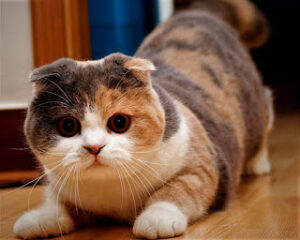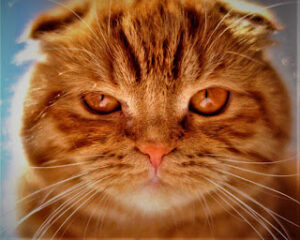The Scottish Fold Cat A Charming and Unique Feline Companion
Introduction to the Scottish Fold Cat
The Scottish Fold cat is one of the most distinctive and beloved breeds in the feline world, instantly recognizable by its adorable folded ears and sweet, round face. With their gentle temperament, playful nature, and affectionate personality, these cats have won the hearts of pet lovers worldwide.
Whether you’re considering adopting a Scottish Fold or simply want to learn more about this enchanting cat breed, this guide covers everything—from their origins and personality traits to health considerations and care tips.
History and Origins of the Scottish Fold Cat
A Genetic Mutation in Scotland
The Scottish Fold’s story began in 1961 on a farm in Perthshire, Scotland, where a shepherd named William Ross noticed a white barn cat named Susie with unusual folded ears. This unique trait was caused by a natural genetic mutation affecting cartilage development.
From Barn Cat to Beloved Breed
Ross and his wife bred Susie, leading to the establishment of the Scottish Fold breed. However, due to concerns about potential health issues (like osteochondrodysplasia), some cat registries, including the GCCF (UK), stopped recognizing them. Despite this, the breed gained popularity in the U.S. and is now accepted by CFA, TICA, and other major associations.
Celebrity Influence
Scottish Folds became even more famous when Taylor Swift, Ed Sheeran, and other celebrities adopted them, boosting their global appeal.
Physical Characteristics of the Scottish Fold Cat
Signature Folded Ears
The breed’s most defining feature is its small, folded ears, which give them an owl-like appearance. Not all Scottish Folds have folded ears—some have straight ears (called “Straights”), but they still carry the gene.
Round Face & Big Eyes
With their large, expressive eyes and rounded cheeks, Scottish Folds have an eternally sweet, kitten-like expression.
Compact, Muscular Body
They have a medium-sized, well-rounded body with a sturdy build. Adults typically weigh 6-13 pounds, with males being larger than females.
Plush Coat Varieties
Scottish Folds come in both short-haired and long-haired (Highland Fold) varieties, with coat colors ranging from solid, tabby, bicolor, to pointed patterns.
Scottish Fold Cat Personality & Temperament
Sweet and Affectionate
Scottish Folds are known for their gentle, loving nature. They enjoy cuddling and often form strong bonds with their families.
Playful & Intelligent
These cats are curious and smart, enjoying interactive toys, puzzle feeders, and even learning tricks.
Quiet & Adaptable
Unlike vocal breeds like Siamese, Scottish Folds are soft-spoken, using quiet chirps and purrs to communicate. They adapt well to apartments and family homes.
Good with Kids & Other Pets
Their easygoing temperament makes them great companions for children, dogs, and other cats.
Caring for a Scottish Fold Cat
Grooming Needs
- Short-haired Folds: Weekly brushing.
- Long-haired Folds: 2-3 times a week to prevent mats.
- Regular ear cleaning(due to folded ears trapping wax).
Diet & Nutrition
- A balanced, high-quality dietto maintain joint health.
- Avoid overfeeding, as they can gain weight easily.
Health Considerations
Due to their genetic mutation, Scottish Folds may be prone to:
- Osteochondrodysplasia(a cartilage disorder that can cause joint pain).
- Arthritis & mobility issues(especially in older cats).
- Ear infections(because of their folded ears).
Responsible breeding minimizes risks, so always choose reputable breeders who test for genetic conditions.
Fun Facts About Scottish Fold Cats
- They Sit Like Humans– Scottish Folds often sit in a “Buddha position”, with their paws on their belly.
- All Folds Descend from Susie– Every Scottish Fold today is related to the original barn cat, Susie.
- Maru, the Internet Sensation– The famous YouTube cat Maru (a Scottish Fold mix) has millions of fans worldwide.
Is the Scottish Fold Cat Right for You?
Best For:
- Families with kids or other pets
- First-time cat owners
- Those who want acalm, affectionate companion
Not Ideal For:
- People concerned aboutpotential joint issues
- Those who prefer ahighly active, vocal cat
The Scottish Fold cat is a charming, sweet-natured breed that brings joy to any home. With their unique looks, loving personality, and playful spirit, it’s no wonder they’re so adored.
If you’re ready for a loyal, low-maintenance, and utterly adorable feline friend, the Scottish Fold might be your perfect match!
Would you adopt a Scottish Fold? Let us know in the comments!
Scottish Fold Cat
History
The Scottish Fold cat is a unique breed in its own way, as it has a very non-standard shape of the ears, which is reflected in the name itself. Also, from the name, it is clear that the homeland of these pets is Scotland, namely – a farm in the Tayside area, near the town of Kupar-Angus.
The first representative of the breed named Susie, snow-white in color, (like her mother), was born completely by accident – her brothers and sisters had ears of a completely standard type. The owner of the farm, Mack Reis, who owned the kittens, noticed a deviation from the norm a few weeks after their birth.
Susie grew up and in 1963 gave birth – among her kittens, two also had white hair, and folded ears. The farmer had a neighbor – William Ross, a cat lover and just an inquisitive person who immediately drew attention to non-standard pets. After some thought, he came up with the idea to breed a completely new breed, and for this purpose he acquired one of the kittens, calling him Snooks.
Mating occurred with British Shorthair (on the advice of the authoritative British geneticist Peter Dite), which subsequently somewhat affected the characteristics of the breed he bred. William Ross and his wife Mary put a lot of effort into ensuring that today we can get these amazing cats.
Associations of cat lovers classify the varieties of the breed in different ways, but it is important for us to understand that, in general, there are only two of them.
The first has a longer coat, which was the result of mating with Persian cats. The second does not have folded ears, although it has the same features of individuality and physique. There is some controversy about these cats, and most consider them a separate breed. Scottish Straight (if a Scottish Fold kitten does not have ears, it is classified as a Scottish Straight-eared kitten, although not everyone agrees with this division).
Surprisingly, the Cat Fanciers Association of America adopted the breed earlier than the British Association. Scottish Fold received championship status from the Cat Fanciers Association of the United States (CFA) in 1977 (in 1978 it received the championship title).
Description
Scottish Fold will be a wonderful companion for the whole family and an affectionate friend of children. At the same time, the cat will feel great if it has one owner, giving him all the kindness of his soul. These cats live an average of 15 years and retain playfulness even in adulthood. The body is medium-sized, the legs are short and strong, and the build is correct and harmonious.
Health problems require close attention from the first months of a kitten’s life, however, the percentage of deviations in pets according to recent studies is becoming less from year to year. Apparently, natural selection plays a role, therefore, without fear, get a cat of the Scottish Fold breed. Colors can be completely different – in this regard, you have huge freedom of choice.
Personality
This breed is distinguished by great kindness, and friendliness and shows its love to all family members. At the same time, cats over time tend to single out the closest person to themselves, and in relation to him express the greatest cordiality, trust, and affection.
The Scottish Fold cat, in general, is not very active, and therefore sometimes needs stimulation to avoid the accumulation of excess weight. Here much depends on the owner – the pet can become something like a kind and affectionate soft pillow, or maintain a normal level of activity. This is also due to the amount of food, which is natural.
Scottish Fold has an innate curiosity, and can sometimes show arrogance, but is very friendly to children and other animals, including dogs (if they are not aggressive).
Characteristics of the breed
Adaptability 10/10
Attachment to family 10/10
Game activity 06/10
Intelligence 07/10
General Health 09/10
Hair loss 06/10
Child-friendly 08/10
Dog friendly 10/10
Love of meows 02/10
Breed Information
| Country of origin | Scotland |
| Lifetime | 11-14 years |
| Size | Average |
| Weight | Cats: 5-6 kg, Cats: 3-5 kg |
| Coat type | Shorthair |
| Color | any colors and patterns of wool |
| Lifestyle | outdoors / indoors |
| Price | 1000 – 1500 $ |
Common diseases
Polycystic kidney disease. PKD is a hereditary disease. Owners need to be vigilant, as symptoms can begin to appear already at a fairly early age. Polycystic kidney disease causes the formation of cysts in the kidneys, which does not allow the organs to function normally. Subsequently, there is a risk of chronic renal failure.
The gene for “folded ears”. The gene that is responsible for folded ears is not completely dominant and can cause cartilage and bone disorders in some cats. Moreover, even if only one of the parents is a representative of the Scottish Fold breed. Ear diseases in many cause concern, in fact, unfounded – an increased tendency to ear infections, ticks, and deafness, with normal care is not observed.
There may also be skeletal defects associated with the “folded ears” gene, such as a short thickened tail, less flexible than in a normal cat. Other abnormalities may include rough paw bones and splayed fingers.
Care
Since the Scottish Fold is mainly short-haired cats, in many respects the care of them is simplified. Once a week, the wool should be brushed, and this is enough. On the other hand, there is also a long-haired variety of this breed, which originated from mating with Persian cats, and their coat should be combed more often and carefully.
Special attention should be paid to the ears, because of the peculiarities of their structure. They need to be cleaned at least several times a week, with special care and accuracy, and it is highly desirable that this is done by the person whom the cat trusts the most. Also, once a week you need to trim the claws, and brushing your teeth is carried out ideally every day, or at least several times a week.









